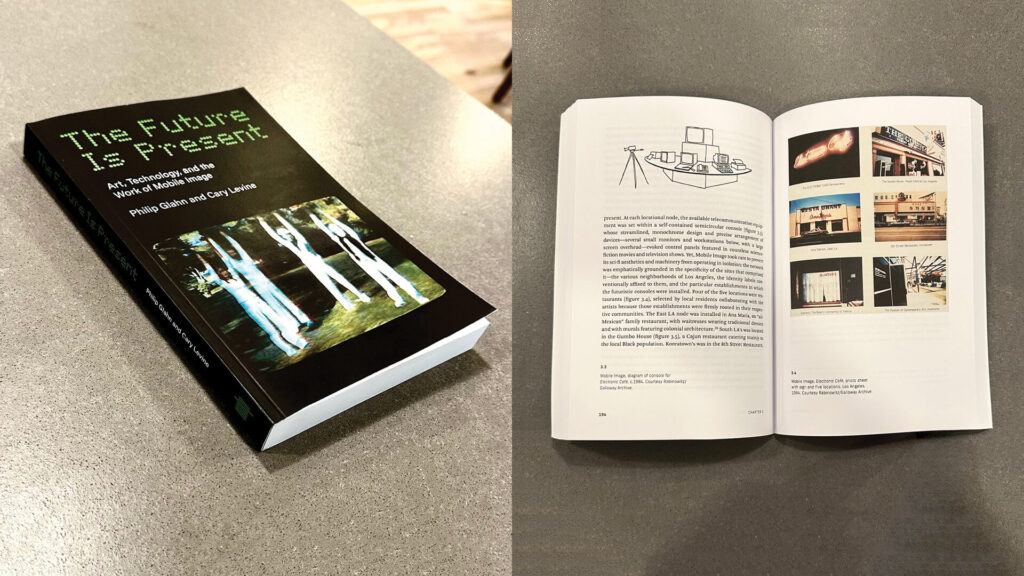[ad_1]
The Future is Present is a recent publication that explores the work of Mobile Image, a visionary new media art collective that was founded by Kit Galloway and Sherrie Rabinowitz in 1977, in Los Angeles, United States. It is co-authored by Philip Glahn, Associate Professor of Critical Studies and Aesthetics, Tyler School of Art and Architecture, Temple University, Philadelphia and Cary Levine, Associate Professor of Contemporary Art History, University of North Carolina, Chapel Hill. The book was published on June 18, 2024, by the MIT Press and tells the story of an important and understudied practice that is as relevant today as it was in the ‘70s and ‘80s. Glahn and Levine join STIR in an interview to discuss Mobile Image’s prescient artmaking.

In 1976, NASA released an open call to the general public, to propose experiments to be carried out via satellite. Galloway and Rabinowitz—both had a background in video art and were living in France at the time—began to envision how televisual human interaction across great distances might look like through satellite transmission. Having hitherto failed to gain access to the necessary technology, they left for the US and began working on a proposal. The duo dubbed their collaborative artmaking Mobile Image and over seven years, would collaborate with several artists and technologists to undertake three ambitious new media art projects that activated telecommunications technology. These were Satellite Arts (1977), Hole in Space (1980) and Electronic Café ’84 (1984), the first of which realised part of their proposal to NASA.

Galloway and Rabinowitz recognised from the outset that a communications revolution is primarily about establishing alternative social realms as ‘laboratories of resocialisation, as technologies of the self’…
– Philip Glahn, Associate Professor of Critical Studies and Aesthetics, Tyler School of Art and Architecture, Temple University, Philadelphia, and Cary Levine, Associate Professor of Contemporary Art History, University of North Carolina, Chapel Hill
Glahn and Levine discuss the primary motivations behind the pursuits of the art collective, telling STIR, “Questions of what technology is, how it is intertwined with subjectivity, agency and identity and, who gets to determine its formations and protocols (corporations? governments? ‘the people’?) were paramount.” They point out that we know now how this chapter of technological history concluded, which is no doubt a reference to the contemporary prevalence of dubious tech-centric activities such as cyber surveillance, cyber warfare, data brokerage and targeted digital advertising on social media. Perhaps, more importantly, Glahn and Levine are turning our attention to the benefactors of such activities, media and commerce corporations and governments (often at the expense of netizens).

The world of digital connectivity that Mobile Image envisioned stood in sharp contrast to our present conditions. As the authors put it, “Mobile Image placed emergent communications technologies—what are today often lumped together as “new” or “social” media—in the hands of the public and allowed them to use them however they saw fit.” Their vision was a utopic one: Where digital communication technologies would be a driving force behind greater self-representation, social unity and creative collaboration.

To quote from the book, “Galloway and Rabinowitz recognised from the outset that a communications revolution is primarily about establishing alternative social realms as “laboratories of resocialisation, as technologies of the self”…” Perhaps all has not been lost in this regard, as the emergent world of Virtual Reality (VR) and the metaverse, have given users across the globe the power to shape their representation in largely unrestricted interactions with each other. However, this is undoubtedly a far cry from the far-reaching optimism of Mobile Image’s work.

Harkening back to their three defining works, the first of these—Satellite Arts (1977)—brought multiple performance artists together across the United States, by connecting their televisual images through satellites. This was a pathbreaking endeavour in digital media and performance art that displayed technology’s potential for creative collaboration. Furthermore, it portrayed tech as an environment for artists to exist and work in, rather than a mere set of tools to be used for artmaking.

Mobile Image’s second major creation Hole In Space (1980) would see the art group set up a real-time public space video conference between New York and Los Angeles, which the general public would activate over three November evenings to connect with strangers and their loved ones, across the cities. Impressive as it was, this was perhaps their third and final artistic undertaking. Electronic Café ’84 (1984) perfectly encapsulated their politics of community-led collaboration. The project was commissioned for the 1984 Summer Olympics in Los Angeles. It provided the public with then-advanced technological tools across five of the city’s cafés, each of which was rooted in one of the distinct communities that make up the rich cultural milieu of Los Angeles. Visitors to the cafés could write in any language using electronic writing tablets and save and share images with café patrons across the city. Additionally, they could share screens and collaboratively develop these images, even print out hard copies.

Mobile Image would not outright disband after Electronic Café ’84, but Galloway and Rabinowitz would begin the Electronic Café International (ECI) in 1988, which was headquartered in Santa Monica and conducted various experiments in telecommunications, spanning decades. While Mobile Image may never have garnered their rightful acclaim as new media pioneers in their heyday, The Future is Present treats us to an invaluable body of research that highlights their continued relevance and is a welcome addition to 2024’s art books. As Glahn and Levine put it, “We argue that Mobile Image’s approach to art, technology and collectivism continues to resonate, providing lessons not only on what ‘went wrong,’ but more importantly on what is still possible…”
‘The Future is Present’ was published on June 18, 2024 by the MIT Press.
[ad_2]
Source link
